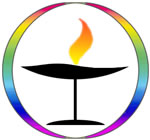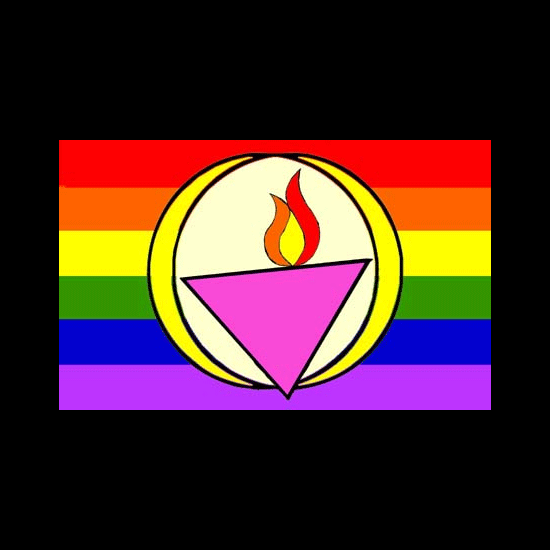To Question is the Answer!
Welcoming Congregation
History
In 1987 the Unitarian Universalist Association (UUA) established the Common Vision Planning Committee. This committee found many negative attitudes, deep prejudices, and profound ignorance about bisexual, gay, and lesbian people, which resulted in the exclusion of bisexual, gay, and lesbian people from their churches. As a result of these findings the delegates of the 1989 UUA General Assembly voted overwhelmingly to initiate the Welcoming Congregation program to educate its members. Each congregation adapts the program to best meet its goals and each unique situation can bring positive changes to individuals and congregations.

The Program
The Welcoming Congregation Program is a completely volunteer program for congregations that see a need to become more inclusive towards bisexual, gay, lesbian, and/or transgender people. It consists of a series of workshops developed by the UUA. The goal of the workshops is to reduce prejudice by increasing understanding and acceptance among people of different sexual orientations. Some of the workshop titles include: How Homophobia Hurts Heterosexuals; Connections to Other Forms of Oppression; Gender Socialization and Homophobia; and Biblical Perspectives on Homosexuality.
Why Just Bisexual, Gay, Lesbian and/or Transgender?
Why single out bisexual, gay, lesbian, and/or transgender people? The Rev. Douglas Morgan Strong probably states it best in the Welcoming Congregation manual: “For centuries, the church has been a leading force against sexual minorities. It is not surprising that gay people are reluctant to reach out to the very institution that oppresses them. Yet, gay, lesbian, [transgender], and bisexual people have no less need for warmth, caring, and affirmation than anyone else who calls the liberal church their religious home. In fact, as a subculture in society gay, lesbian, [transgender], and bisexual people may need our support more than the general population.”
Being a Welcoming Congregation
Congregations who publicly and successfully welcome bisexual, gay, lesbian, and transgender people have the following qualities:
* Includes and address the needs of b/g/l/t persons at every level of congregational life—in worship, in programs, in social occasions, and in rites of passage—welcoming not only their presence, but the gifts and particularities of their lives as well.
* Assumes the presence of b/g/l/t people and celebrates this diversity by having inclusive language and content in their worship.
* Fully incorporates the experiences of b/g/l/t persons throughout all programs, including religious education.
* Includes an affirmation and nondiscrimination clause in our by-laws and other official documents affecting all dimensions of congregational life, including membership, hiring practices, and the calling of religious professionals.
* Engages in outreach into the b/g/l/t community in its advertising and by actively supporting b/g/l/t affirmative groups.
* Offers congregational and ministerial support for union and memorial services for b/g/l/t persons, and for celebrations of...family definitions.
* Celebrates the lives of all people and welcomes same-sex couples, recognizing their committed relationships, and equally affirms displays of caring and affections without regard to sexual orientation.
* Seeks to nurture ongoing dialogue between bisexual, gay, lesbian, transgender, and heterosexual persons and to create deeper trust and sharing.
* Encourages the presence of a chapter of Interweave.
* Affirms and celebrates b/g/l/t issues and history during the church year.
* Attends to legislative developments and works to promote justice, freedom, and equality in the larger society.
* Speaks out when the rights of bisexual, gay, lesbian, and transgender people are at stake.
* Celebrates the lives of all people and their ways of expressing their love for each other.
People of faith, standing on the side of love
For more information, visit the UUA's Office of Bisexual, Gay, Lesbian and Transgender Concerns. Their Vision Statement reads" The Office is guided by the vision that someday we will be able to put ourselves out of business and that oppression against bisexual, gay, lesbian, and/or transgender people, whether it be overt or subtle, will be a thing of the past. '


Aren't We Already a Welcoming Congregation?
Is it true that our church probably meets most of the qualifications for a Welcoming Congregation? Our church by-laws state that we do “not discriminate on the basis of age, race, occupation, gender, past religious affiliation, or sexual orientation.” Our membership already includes bisexual, gay, lesbian, and transgender persons who are active members, willing to give of themselves and share their experiences with us. However, official recognition as a Welcoming Congregation allows us to open our church as safe space for bisexual, gay, lesbian, and transgender persons; to take positions on oppression in our larger communities; and to accomplish outreach.
Melanie Walters and Art Brewer conducting a Welcoming Congregation workshop
